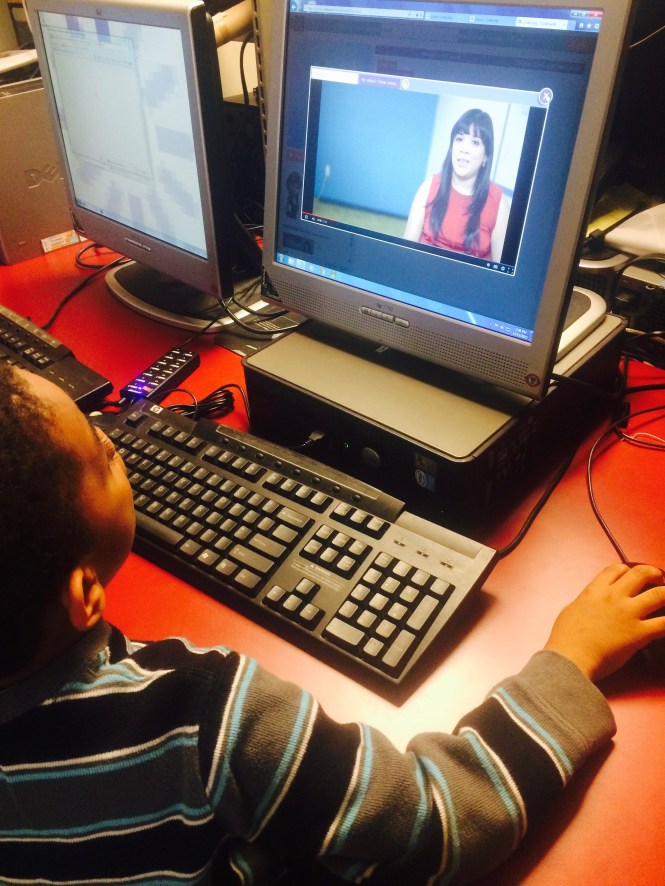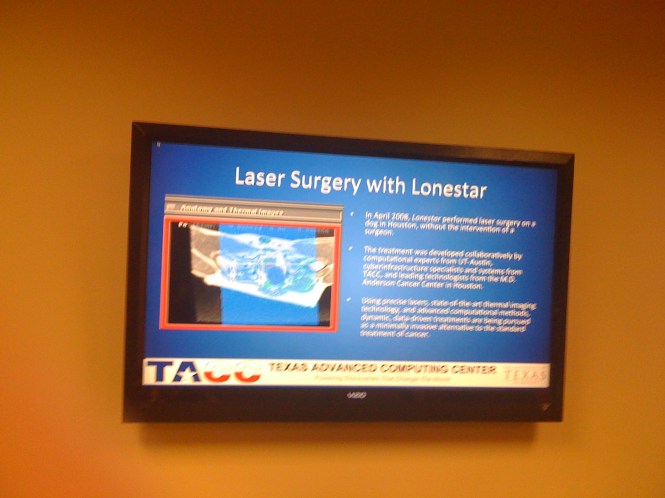
Students explore visualizations of the oil spill.
We all know that many students are not anywhere near talented teachers who can give them the information they need to be curious, understanding, interested and involved in the STEM initiatives. For many there is no pipeline, no indepth knowledge of any of the subjects that will create workforce, or future readiness for careers.
As a career STEM teacher, I was teaching science, math, problem solving, engineering and the use of technology early, i caught a lot of flack. There were helpful groups of people and organizations that reached out to me, to others and who helped us to become the teachers that need to be STEM educated. There were these teachers an d we were ridiculed during the Bush administration for teaching science. It was the bottom of the needs totem pole for M. Spellings. So we were not groomed, by our school systems or regarded in a good light. Political winds blew us away.
There was

Astronomy , space science education, the Chalenger Center Programs, so many offerings
, NASA’s Education Materials Finder will help teachers locate resources that can be used in the classroom. Users may search by keywords, grade level, product type and subject. With hundreds of publications and Web sites indexed, the finder is the best way to locate NASA educational resources.
› Find Materials Now

We meet the world on the news , but do students know where in the world the news is coming from?
The National Geographic Society and its Outreach to Teachers
Community, Education, and Student Outreach, http://www.informationweek.com/news/231003049
education.nationalgeographic.com
Most remarkable in the way of transformational and experiential teaching was the experience offered by the National Geographic. It was not just an experience for me. There are Alliance groups within the Geographic. There are opportunities. I had a month of involvement in all things geographic. What they have to offer changes as the programs expand. There is a section on education, there are special programs, , there are lesson plans and there are mentorships to be had in the AAGE.
National Geography Standards
The first ever national geography standards, Geography for Life, were published in 1994 and are being voluntarily adopted around the country. These geography standards are benchmarks against which the content of geography courses can be measured. Standards will affect the education of all children in the United States, and they should be part of the program of instruction of schools in your community. Copies of Geography for Life are available for purchase from the NCGE store.
The Geography Standards Framework consists of two levels. At the first level, the subject matter of geography is divided into six essential elements. By essential we mean that each piece is central and necessary; we must look at the world in this way. By element we mean that each piece is a building block for the whole. At the second level, each essential element contains a number of geography standards, and each geography standard contains a set of related ideas and approaches to the subject matter of geography.
National Geography Standards
The first ever national geography standards, Geography for Life, were published in 1994 and are being voluntarily adopted around the country. These geography standards are benchmarks against which the content of geography courses can be measured. Standards will affect the education of all children in the United States, and they should be part of the program of instruction of schools in your community. Copies of Geography for Life are available for purchase from the NCGE store.
The Geography Standards Framework consists of two levels. At the first level, the subject matter of geography is divided into six essential elements. By essential we mean that each piece is central and necessary; we must look at the world in this way. By element we mean that each piece is a building block for the whole. At the second level, each essential element contains a number of geography standards, and each geography standard contains a set of related ideas and approaches to the subject matter of geography.
Earthwatch Education
Earthwatch fellowships enable critical partners to participate in research expeditions worldwide. Each year, Earthwatch’s Fellowship Programs enable hundreds of students, teachers, conservation professionals, and corporate employees to join expeditions at little or no out-of-pocket expense. Earthwatch Fellows are emissaries of the Earthwatch mission, sharing their experiences and new knowledge with thousands of students, teachers, and colleagues upon their return.
Educator Fellowships
Summer Fellowships
Get out of the classroom and head into the field to learn about cutting edge research and conservation efforts, to develop professional skills, and to make a difference for our shared environment! As a summer educator fellow, you’ll spend 1-2 weeks of your summer recess on an Earthwatch expedition alongside a diverse team of volunteers led by prominent field researchers. After your expedition, you’ll bring the world back into your classroom and to your students as you’ve never done before.
Learn more about our Summer Fellowship program.
Live From the Field
Live From the Field educator fellows join Earthwatch research teams during a brief portion (7 to 10 days) of their school year and share their experiences with classrooms at home using blogs containing, photos, videos, lessons, and activities. Live From the Field educator fellows also connect with students through live video and phone conferencing at scheduled times during their expedition.
I joyously participated with other teachers in Earthwatch Outreach. It was fun to be an Earthwatch fellow. Working with a scientist in the field using technology to share the archeological findings was hard work, but rewarding. I learned the culture of the island, the history of Mallorca, I learned about archeological excavation , and how we could use technology to map the site and the finds. Many teachers have been Earthwatch Fellows. The experience can be a life -changing event. Who knew about the other history I learned so much about . The cultures of the Med were unknown to me. Dr. William Waldron was the PI at the time. I participated in a further grant, we mapped the Mongoose popution of St. Martins .. and then volunteered to do Turtle nests , at night , another project. Nothing in a textbook can match the experience. Nothing!
K-12 classroom educators of any subject(s) from public or private schools nationwide are eligible to apply for Earthwatch fellowships. The strongest applicants are those who are passionate about teaching, excited about making a difference with their time and talents, and committed to engaging their communities using their knowledge, passion, and energy.
A starting point is the Education Department of the National Geographic. I don’t remember why I knew about them, or what I saw that made me apply to a summer institute.
, NSTA and their workshops, NCTM and their initiatives , Shodor.org and their free resources, the Fish and Wildlife Service, 4H and the SET program, the Exploratorium, and wait there are more, but I won’t name them all.
There is a digital divide, and there are resources everywhere, if teachers can access them, but given the state of broadband, in many areas that are rural and distant , the people who are concerned about STEM , are creating a false illusion that teachers create the problem.
There is also the knowledge that we in the classrooms have a mandated methodology which we can tweak but the management, ie the school boards and policy people make most of the decisions. So, what ‘s a teacher to do? Stay tuned. The age of Sputnik is over!!
The age of Transformation , has begun in Education.
http://chronicle.com/article/A-Size-That-Fits-All-for-the/128421/

Outreach to the public sharing research = Oil Spill simulation
Michael Morgenstern for The Chronicle
By Hal Salzman and B. Lindsay Lowell
The strength and size of the nation’s science-and-engineering work force are the subject of much concern, following the Obama administration’s education initiatives; international testing that shows students in Shanghai at the top of the world; and, last year, an update of the influential report “Rising Above the Gathering Storm.” That report finds the deterioration of America’s competitiveness so severe that it is likened to a Category 5 hurricane. It calls for the United States to create a “New Sputnik” education initiative and expand our science-and-engineering work force. It reinforces a common worry over American students’ lackluster international standing compared with those in several Asian nations and in a handful of small European nations.
We believe that those concerns are overstating and misidentifying America’s challenges in science and engineering, and that they are missing the real opportunities for improving the nation’s education and work force. As we examined the evidence, several points became clear: The United States needs to improve education broadly rather than expand particular fields of study; look inward rather than abroad for exemplary educational models, in light of the limits of international comparisons; and focus on the core lessons about improving the lowest-performing group of students. There is actually no compelling evidence that, over all, the educational pipeline is failing to meet demand.
Our recent analysis of Department of Education data for three decades followed students from high school to the job market. We found little in the way of overall change in students’ pursuit of science-and-engineering studies or their entry into those careers over the past 30 years. We found that while a steady proportion of college students graduated in science and engineering, no more than half of them landed jobs in a formally defined core science or engineering occupation.
So, given a steady supply, why do companies report difficulty in finding ideal workers? Listen carefully and it sounds as if the employers would like entry-level workers to have skills not typical of newly graduated students. Leading engineering companies seek technologists with a depth of skill in a technical area combined with a broad education across technical fields, business, and the social sciences. Colleges find it difficult to develop all of that in only four years. So the hiring difficulty may reflect problems with pedagogy, the structure of higher education, the unwillingness of some employers to train new workers, and a lack of collaboration between academe and industry. It does not, however, indicate a loss of student interest or a shrinking pool of science-and-engineering graduates.
Nevertheless, some policy makers and industry leaders believe that to meet the demands of our knowledge economy, more such education is needed. They even think it is preferable to other fields of study. While acknowledging the value of science-and-engineering knowledge, we find that it is but one of many forms of valuable knowledge. Moreover, the science-and-engineering managers we interviewed expressed dissatisfaction with the “soft” communication, or teamwork, skills of their new engineers. And changes in hiring patterns suggest that the nation’s economic future depends on developing a balanced portfolio of well-educated workers across the spectrum of skills, knowledge, and disciplines.
Finally, some industry lobbying groups and high-tech companies seek to augment the supply of domestic workers by importing foreign labor on temporary visas. But this confuses the purpose of those programs with the country’s immigration policy for citizens-in-waiting. Immigration policy is driven by a long-term vision and a wide range of social and political objectives. The original intent of temporary-visa programs, on the other hand, was to meet short-term, not structural, labor shortages. Ensuring that labor markets are not distorted by short-term visas, which in their current form lead to a number of labor-market and social problems, is not anti-immigrant, and does not undermine the strength of U.S. science and engineering. In fact, raising the numbers of temporary visas for foreign workers during cyclical talent shortages can distort labor markets and discourage domestic students from careers in engineering and the sciences.
While we do not maintain that our study, or any one study, is definitive, we do believe that influential groups should consider new evidence in their quest to advance science, technology, and economic growth. When we look at the past three decades, the data support a far more favorable set of conclusions on student performance and supply than those promulgated by critics of the so-called STEM (science, technology, engineering, and math) pipeline. At the same time, our research supports the widely recognized fact that women and minorities are the most likely future source of STEM workers, and, discouragingly, that where the education system is most clearly failing is precisely for those populations. Of course, focusing on the big picture leaves out clear-cut examples of unfilled shortages of workers in esoteric but crucial occupations.
The classic tried and true formulation is that supply follows demand or, less sanguinely, that depressed wages and discouraged workers result if supply outstrips demand. To avoid those problems, a number of demand-side policies should receive support from all quarters. These policies include stable and increasing government financing for research, reinvigoration of lagging private-sector investments in research, tax breaks and other incentives for research-and-development activities, and the creation of an environment that encourages entrepreneurship. In terms of education, however, the evidence clearly points to improving basic education for low-performing students, schools, and populations—not an attempt to artificially inflate the number of science-and-engineering degrees awarded.
Hal Salzman is a professor of public policy at Rutgers University at New Brunswick. B. Lindsay Lowell is director of policy studies at the Institute for the Study of International Migration at Georgetown University.
THE JACK kENT COOKE FOUNDATION
No Gifted Child Left Behind? First, the good news: It turns out, millions of kids from low-income families are acing standardized tests. Now, the bad news…http://www.jkcf.org/news-knowledge
With the tests we find that there are many who have the capacity to learn, to create to innovate, but, sadly nothing happens. Download the report, here is the summary.
Today in America, there are millions of students who are
overcoming challenging socioeconomic circumstances
to excel academically. They defy the stereotype that poverty
precludes high academic performance and that lowerincome
and low academic achievement are inextricably
linked. They demonstrate that economically disadvantaged
children can learn at the highest levels and provide hope
to other lower-income students seeking to follow the
same path.
Sadly, from the time they enter grade school through
their postsecondary education, these students lose more
educational ground and excel less frequently than their
higher-income peers. Despite this tremendous loss
in achievement, these remarkable young people are
hidden from public view and absent from public policy
debates. Instead of being recognized for their excellence
and encouraged to strengthen their achievement, highachieving
lower-income students enter what we call the
“achievement trap” —
educators, policymakers, and the
public assume they can fend for themselves when the facts
show otherwise.
Very little is known about high-achieving students
from lower-income families — defined in this report as
students who score in the top 25 percent on nationally
normed standardized tests and whose family incomes
(adjusted for family size) are below the national median.
We set out to change that fact and to focus public attention
on this extraordinary group of students who can help
reset our sights from standards of proficiency to standards
of excellence.
This report chronicles the experiences of highachieving
lower-income students during elementary
school, high school, college, and graduate school. In
some respects, our findings are quite hopeful. There
are millions of high-achieving lower-income students
in urban, suburban, and rural communities all across
America; they reflect the racial, ethnic, and gender composition
of our nation’s schools; they drop out of high
school at remarkably low rates; and more than 90 percent
of them enter college.
But there is also cause for alarm. There are far fewer
lower-income students achieving at the highest levels than
there should be, they disproportionately fall out of the
high-achieving group during elementary and high school,
they rarely rise into the ranks of high achievers during
those periods, and, perhaps most disturbingly, far too few
ever graduate from college or go on to graduate school.
Unless something is done, many more of America’s brightest
lower-income students will meet this same educational
fate, robbing them of opportunity and our nation of a
valuable resource.
This report discusses new and original research on
this extraordinary population of students. Our findings
come from three federal databases that during the past 20
years have tracked students in elementary and high school,
college, and graduate school. The following principal
findings about high-achieving lower-income students are
important for policymakers, educators, business leaders,
the media, and civic leaders to understand and explore as
schools, communities, states, and the nation consider ways
to ensure that all children succeed:
 Here is the template. It is gorgeous. Get it for your school, for your community and for those who are interested in helping to create digital age learners.
Here is the template. It is gorgeous. Get it for your school, for your community and for those who are interested in helping to create digital age learners.


























 Paul Resta
Paul Resta

























